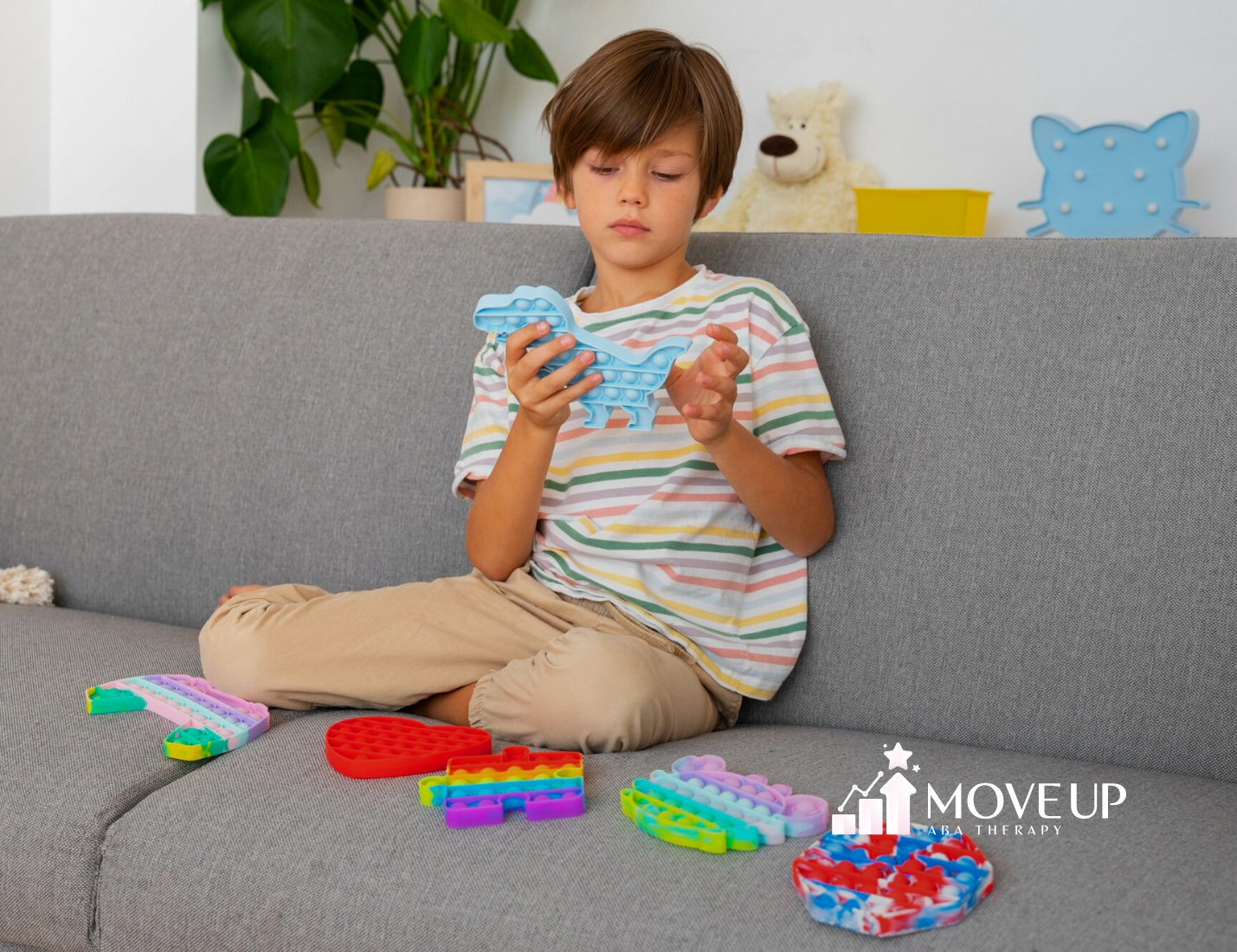Sensory processing difficulties are a core characteristic of autism spectrum disorder (ASD). Many individuals with autism experience heightened or reduced sensitivity to sensory stimuli, which can lead to sensory overload or understimulation. To address these challenges and help individuals self-regulate, sensory breaks can be an effective tool. These breaks allow individuals to temporarily step away from overwhelming stimuli temporarily, engage in calming activities, and restore their emotional and sensory balance.
In this blog post, we will explore what sensory breaks are, why they are important for individuals with autism, and how to effectively incorporate sensory breaks into daily routines. Whether you’re a caregiver, teacher, or therapist, understanding sensory breaks can improve emotional regulation and overall well-being for those with autism.
What Are Sensory Breaks?
Sensory breaks are short, intentional pauses from sensory input. These breaks allow individuals to engage in activities that help them manage their sensory sensitivities, reduce stress, and regain focus. For individuals with autism, sensory breaks can be particularly helpful because they provide a structured way to manage the sensory overload or understimulation that can result from everyday experiences.
During a sensory break, the goal is to engage in activities that provide the right level of sensory input based on the individual’s needs. Some individuals may need calming activities to reduce sensory overload, while others may need more stimulating activities to increase alertness and focus.
Why Are Sensory Breaks Important for Individuals with Autism?
Sensory sensitivities are a hallmark of autism, and these sensitivities can make certain environments or situations overwhelming. For example, a noisy classroom or a crowded shopping mall might cause a child with autism to become overstimulated. Without a way to manage this sensory input, stress levels can increase, leading to meltdowns, anxiety, or withdrawal.
Sensory breaks provide a structured outlet to help individuals manage sensory overload and re-center themselves. Here’s why sensory breaks are crucial for individuals with autism:
-
Prevents Overload: Sensory overload can lead to meltdowns or anxiety. Sensory breaks allow individuals to step away from overwhelming stimuli and give them a chance to calm down before they become too overstimulated.
-
Improves Focus and Productivity: By taking short breaks, individuals can refocus and return to tasks with improved attention and engagement. This is especially helpful in school settings or during therapy sessions.
-
Promotes Self-Regulation: Sensory breaks teach individuals with autism to recognize when they are becoming overstimulated and give them the tools to self-regulate. This builds their independence and ability to manage their own sensory needs.
-
Reduces Stress and Anxiety: Engaging in calming sensory activities during breaks can help reduce anxiety and prevent emotional escalation. This can be particularly beneficial during stressful situations like medical appointments or social events.
-
Enhances Social and Emotional Well-Being: Sensory breaks can help prevent emotional outbursts by giving individuals the space to decompress and self-regulate. This, in turn, fosters positive social interactions and emotional stability.
Types of Sensory Breaks for Autism
Sensory breaks can vary depending on an individual’s sensory needs. The key is to offer activities that align with the individual’s specific sensory preferences and requirements. Below are different types of sensory breaks, each tailored to either calming or stimulating sensory needs.
1. Calming Sensory Breaks
For individuals who are overwhelmed by sensory input, calming sensory breaks are ideal. These breaks help to reduce stress, lower anxiety, and promote relaxation. Common calming activities include:
-
Deep Pressure: Activities like squeezing a stress ball, using weighted blankets, or using a weighted vest can provide deep pressure that helps calm the nervous system.
-
Gentle Movement: Slow rocking, swinging, or gentle bouncing on an exercise ball can help reduce tension and promote relaxation.
-
Quiet Space: Providing a quiet space with dimmed lights and minimal noise allows the individual to retreat from overstimulating environments and regain composure.
-
Breathing Exercises: Deep breathing techniques, like blowing bubbles or breathing through a straw, can help lower stress and anxiety levels.
2. Stimulating Sensory Breaks
On the other hand, some individuals with autism may struggle with sensory under-stimulation, feeling disengaged or lethargic. In these cases, stimulating sensory breaks are beneficial to help them increase focus and energy levels. Examples include:
-
Tactile Stimulation: Activities that engage the sense of touch, such as playing with textured materials like clay, sand, or sensory bins, can increase alertness.
-
Movement-Based Activities: Jumping on a trampoline, running, or using a therapy swing provides proprioceptive input, helping to activate the body and stimulate the nervous system.
-
Fidget Tools: Items like fidget spinners, stress balls, or textured fabrics can help individuals with autism focus by providing tactile stimulation.
-
Bright Lights and Colors: Engaging with colorful lights or vibrant visuals can help stimulate visual processing, especially if the individual is more visually oriented.
3. Nature-Based Sensory Breaks
For many individuals with autism, spending time in nature can provide a calming and restorative sensory experience. Nature-based breaks may include activities such as:
-
Walking or Hiking: A walk through a quiet park or along a nature trail can help individuals reconnect with their surroundings in a peaceful environment.
-
Water Play: Activities like playing with water in a sensory bin, using a water table, or visiting a fountain or pond provide soothing visual and tactile experiences.
-
Animal Interaction: Spending time with pets or animals can offer both calming and stimulating sensory input. Animals provide a soothing presence and can help regulate emotions.
How to Implement Sensory Breaks Effectively
Implementing sensory breaks successfully requires planning and consistency. Here are some strategies to make sensory breaks an effective part of daily routines:
1. Schedule Regular Breaks
It’s important to integrate sensory breaks into the individual’s routine. Regular breaks should be scheduled throughout the day, especially during times when sensory overload is more likely, such as after a lengthy task, during transitions, or when moving from one environment to another.
2. Customize the Breaks
Each individual has unique sensory needs. Some may require more calming input, while others may benefit from stimulating activities. Customize sensory breaks to match the individual’s preferences, and consider using a combination of activities throughout the day.
3. Provide Clear Guidelines
For some individuals with autism, understanding when and why a sensory break is needed can be challenging. It’s helpful to establish clear guidelines about when to take a break, such as using visual schedules or timers. This allows the individual to anticipate breaks and feel more in control.
4. Create a Sensory-Friendly Space
Create a designated area where sensory breaks can occur. This space should be quiet, calming, and free from distractions. It can include cozy items like pillows, weighted blankets, and soft lighting to provide a sensory retreat.
5. Monitor the Breaks
Pay attention to how the individual responds to different sensory activities. Over time, their preferences may change, and it’s important to stay flexible. Keep track of which activities seem to help the most and adjust the breaks accordingly.
Conclusion
Sensory breaks are an essential tool for supporting individuals with autism. Whether the goal is to prevent sensory overload, increase focus, or reduce stress, sensory breaks offer an effective way to help individuals with autism self-regulate and manage sensory input. By incorporating calming or stimulating sensory activities into daily routines, caregivers, teachers, and therapists can enhance the well-being and emotional stability of individuals with autism.
At Move Up ABA, we recognize the importance of sensory breaks in fostering self-regulation and promoting positive behavior. By integrating sensory breaks into ABA therapy, we help individuals with autism better manage their sensory needs and thrive in different environments.
Frequently Asked Questions
1. How often should sensory breaks be taken?
Sensory breaks should be taken regularly throughout the day, especially during times of potential sensory overload. The frequency depends on the individual’s sensory needs, but it is generally recommended to take breaks every 30-60 minutes, or as needed.
2. Can sensory breaks be used in schools or therapy sessions?
Yes, sensory breaks can be very beneficial in schools, therapy settings, and home environments. Educators and therapists can integrate sensory breaks into the schedule to help individuals with autism stay engaged, focused, and calm.
3. What if my child doesn’t enjoy sensory breaks?
If a child does not seem to enjoy sensory breaks, it may be necessary to adjust the activities or the environment. Work with the child to find out which sensory inputs they prefer, and make sure to keep the breaks short and enjoyable to avoid overwhelming them.
Sources:
- https://www.autismparentingmagazine.com/sensory-break-activities/
- https://www.autism.org.uk/advice-and-guidance/topics/sensory-differences/sensory-differences
- https://autismcommunitystore.com/collections/fidgets
- https://www.autism.org.uk/advice-and-guidance/professional-practice/sensory-strategies
- https://www.leicspart.nhs.uk/autism-space/health-and-lifestyle/meltdowns-and-shutdowns/







